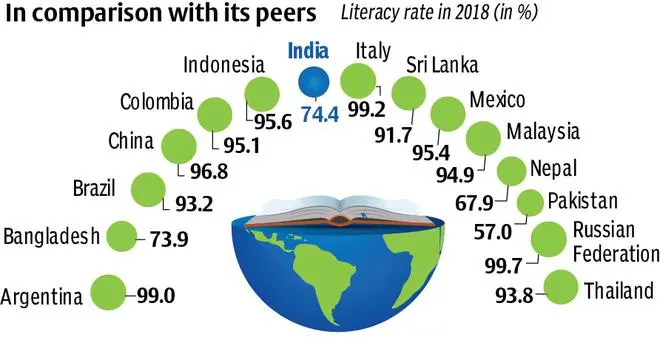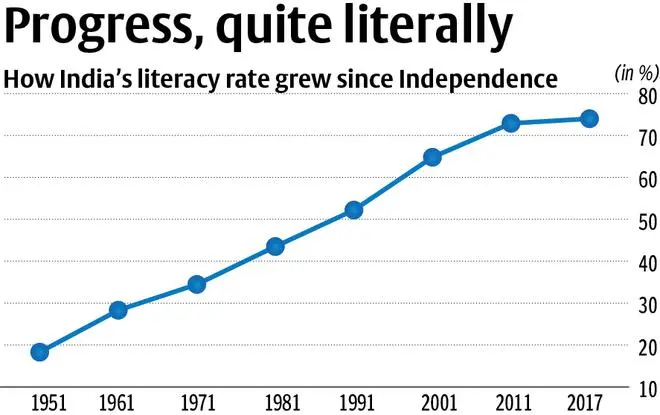In 1947, when India became independent, only a fraction of people could read a sentence without hesitation. The Census document of 1951 shows the literacy rate was 18.3 per cent then.
Cut to 2018, it is pegged at a massive 74 per cent, according to World Bank estimates. The growth was slow, yet steady, making the most progress post liberalisation, between 1991 and 2001. In that period, the proportion of literate people in India shot to 64.8 per cent from 52.2 per cent.
The World Bank describes a literate person as one who can both read and write with understanding a short simple statement about their everyday life.

While India’s achievement is commendable, it still has miles to go, compared with its peers. In 2018, 97 per cent of Chinese citizens were literate, while it was 95 per cent in Mexico and 91.7 per cent in Sri Lanka.

However, some of India’s neighbours, including Pakistan and Nepal are way behind, where 57 per cent and 67 per cent of their citizens, respectively, were literate in 2018, show World Bank data.
States that did well
A comparison of Census documents and the 2017 National Sample Survey showed that Haryana made the most progress between 1971 and 2017 in terms of literacy among the big States.

While only a quarter of the State’s population was literate in 1971, it rose to 80.4 per cent in 2017. The other big States that showed stupendous improvement are Uttarakhand, Chhattisgarh, Assam and Odisha — where the literacy rate rose by over 50 per cent during the period.
On the other hand, Andhra Pradesh has the lowest literacy at 66.4 per cent among big States, followed by Rajasthan at 69.7 per cent, shows NSS. Interestingly, Bihar ranks third in terms of illiteracy in the country, according to the NSS.

The State had topped that list according to the last Census, that was out 11 years back. Between 1971 and 2017, Bihar’s literacy rate grew by 47.13 per cent. And between 2011 and 2017, it grew by 9 per cent.
Kerala tops
With a literacy rate of 96.2 per cent, Kerala continues to be the topper among all States. Data show this has always been the case with this southern State. For instance, in 1951, when the cumulative literacy rate in the country was 18.3 per cent, Kerala recorded a whopping 47.18 per cent. While its literacy rate only grew by 26.45 per cent between 1971 and 2017, it may be noted that the State had an almost 70 per cent literacy rate in 1971.
Gender, money and more
What are the factors that affected literacy rates across the country? The National Family Health Survey 2019-21, assessed people between the ages of 15 and 49 across the country and observed that ‘72 per cent women and 84 per cent men are literate’.
It also notes that only 45.8 per cent of the women who fall in the poorest wealth quintile are literate, while the proportion is 92.2 per cent among the richest women. While 65 per cent of the poorest men are literate, almost all rich men — 97 per cent of them — are literate.







Comments
Comments have to be in English, and in full sentences. They cannot be abusive or personal. Please abide by our community guidelines for posting your comments.
We have migrated to a new commenting platform. If you are already a registered user of TheHindu Businessline and logged in, you may continue to engage with our articles. If you do not have an account please register and login to post comments. Users can access their older comments by logging into their accounts on Vuukle.